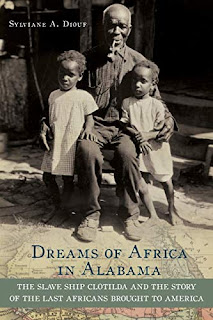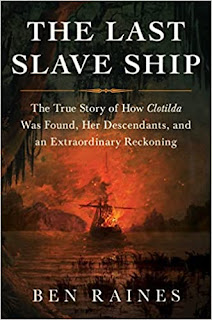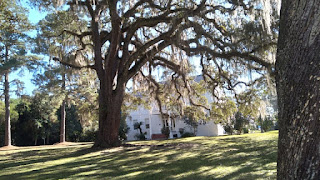 |
| Christmas on the St. Petersburg waterfront under a bright gold full moon. |
Andy and I took another Florida road trip, this time to visit friends we stay in touch with the best we can on social media, cell phones, and passing photos back and forth. We aimed to see them face-to-face, in person, and have those long conversations we remember still, and the warmth and comfort that goes with them. Time for a trip down Memory Lane.
 |
The Villages have everything.
Recreation Center & nature trials. |
When Andy first mentioned a trip to the Villages to see old friends, I pounced on it. "Well sis, if we're going there, why not go down to Tampa/St. Petersburg." I lived in the Tampa Bay area on the Gulf coast of central Florida before taking off for Ukraine with the Peace Corps in 2009, and I loved it. Miss my friends. I'm so glad she said "great idea," because it turned out to be fantastic and wonderful for both of us, a friendship tour.
 |
| Andy, Linda, and I |
First stop, The Villages, to visit Linda and Rodney, with whom Andy's been friends for decades when they lived in Tallahassee. It was fun and heartwarming. We learned that the Villages now has 120,000 residents, 55 golf courses, every activity for seniors imaginable, and 3 zip codes. It's perfect for Linda and Rodney. It was fun being there because we're seniors who know how to laugh and how to keep these aging issues of concern in some perspective. We stick with the positive, enjoy every moment, fully in the now, satisfied and at peace. We had a lovely tour, a great lunch, and good conversation flowing easily between what's happening today and where we were before. We toasted to friendship and good health, and expressed hope we'd visit each other again soon.
 |
Bayfront Hilton
courtyard |
Next up, with Andy driving (a good long-distance driver) and me navigating (pretty good), we headed south and west, a return to the "10 Years a Floridian" chapter of my life. I never thought I would say it, but I grew to love the place. It happened as I worked for the Florida Humanities Council, the NEH state program whose main job is helping Floridians learn about and promote their state.
 |
|
"Make Florida Home." That was the theme. Millions of people come and go in Florida, most born in other places, from some place else, attached to other states. It infuses the culture here. It's a challenge to build that sense of place and attachment that makes you care for it. Snowbirds. Even if they come every winter for decades, or move here permanently in retirement, they call any state but Florida "home." How do you make people care about the State or get them to appreciate its cultural traditions and sacred places? Care about preserving it? How do you encourage them to appreciate its past and present, both the paradise and the Noir? In short, how do you entice them to "Make Florida Home?"
Whenever I'm back in Florida I do feel at home. I came to know the state and to care for it. Familiarity breeds attachment. That was the purpose of the Humanities Council's award-winning magazine, The Forum, as well, which explored all aspects of the State's history and culture, its natural and built environments, its literature, art, music, folklife traditions. It still does.
 |
| My Old Northeast neighborhood, decked out for Christmas. |
I was back in St. Petersburg, back home. The Bay sparkled; the aging brick streets, uneven as ever, rose up to greet me; the houses, the bungalows and variety of architectural styles were beautiful, decorated in their holiday finest; and a short walk to Beach drive and along the Bay to downtown brought comfort and joy.
The development downtown amazes. It is filled up with high rises on every available space, along with great Museums, lots of tourists attractions, cafes and restaurants. It's like New York City on Tampa Bay, I marveled. Sandie and Christopher snidely snickered. "Overdeveloped," they said. They live downtown, and they've seen it happen.
Still, I savored the flaura and fauna, the exotic flowers blooming like happy faces under the Florida sun and the balmy weather, the Live Oaks and ancient Banyon trees across from what once was the iconic
Moon Under Water English pub. We spent lots of time there. My grandkids played around those Banyon trees whenever they visited their Nana. So many happy memories.
 |
A fav memory photo:
Sandie & me |
But best of all was seeing dear Sandie and Christopher. It's been too long we all agreed, hugs and love flowing. They were friends with our brother Loren, too. Christopher helped Loren self-publish his memoirs, "
An Asperger Journey." Sipping wine and savoring memories, Sandie brought out the lovely Indian elephant sculpture that Loren had given her as a gift many years ago. We shared time. We shared meals and thoughts. We had an evening meal at Cervice's because it was a place we spent so much time together. It's no longer the Moon, but we shared a lovely dinner of tapas and wine at "what used to be." And as an added bonus we got to bask in the waterfront under a brilliant gold moon. Just like old times.
But the good times continued the next morning with Sue Johnson, a friend going back to Ohio days. Sue is an art therapist, a talented artists, and a Tai Chi master teacher. We had a lovely breakfast at the historic Hollander hotel, a place her daughter stays when she visits her mom. We just took up from where we left off a few years back in St. Pete, our memories bridging Ohio and Florida, and lots of space in between. Sue updated Andy and I on the museum world in St. Pete, the
Chihuly Collection and her new favorite,
The Museum of the Arts and Craft Movement. Just three-years-old, this architectural wonder was founded by philanthropist and collector Rudy Ciccarello. Sue said the art was incredible. She made it sound so fantastic that I will have to return to St. Petersburg just to see this museum.

After musing about my next visit, Andy and I wound our way over the Howard Frankland bridge to Tampa to see dear friend Linda Ketley. She is an intrepid entrepreneur to this day, restoring houses and making them beautiful, helping friends with buying and displaying art and rare artifacts from around the world. Linda had just learned her sister Julia from England had died. We felt sad for her. Linda's family lives in the UK, where she has dual citizenship. I have always loved her international view of life and her multicultural interests, intrinsic to a beautiful woman whose Dad was Chinese and her mom English. Our thoughts are with Linda during this grieving time.

Our friendship tour was coming to an end, but we had one more stop to make in Tampa as we headed home to Tallahassee. We were going to see another friend with Ohio roots, the incomparable Dan Bitter from Toledo's Old West End days. We've been friends ever since, even though Dan fell off our roof and broke his arm when he was painting our house. That's a story in itself.
Dan is a walking encyclopedia of knowledge with never-ending curiosity. "I'm reading a book now on advances in Astronomy and space," he tells us. Just like Dan! He marvels at what's going on out there, among the planets and asteroids in the forever universe.
This is why I am Dan's ever-loving friend. He is the most brilliant guy I know, and also the kindest, most compassionate, a wonderful listener and loyal friend. And on top of all that, he made us a delicious crepe from a recipe he got from our mutual Old West End friend Sandy Frank. He topped it off with drops of fresh lemon and powdered sugar, and voila, the perfect crepe!
Nor is it any wonder that Dan's home and big yard is an oasis for progressive souls, free spirits, and extra-talented friends who come to his place for movies, crepes on Sunday, and eclectic conversation among kindred spirits. Dan collects all good people and puts them together in memorable and meaningful ways. And, true to form, it happened this visit, too.
 Dan connected Andy and I with Marie Haley, whose lifelong partner was award-winning crossword puzzle maker Merl Reagle. Okay, puzzle fans, you know who he is. Merl died a few years ago, but his crossword puzzles live on. Dan made sure Marie came for his Sunday crepes when he learned that Andy is an "incorrigible puzzlehead," as Merl called them.
Dan connected Andy and I with Marie Haley, whose lifelong partner was award-winning crossword puzzle maker Merl Reagle. Okay, puzzle fans, you know who he is. Merl died a few years ago, but his crossword puzzles live on. Dan made sure Marie came for his Sunday crepes when he learned that Andy is an "incorrigible puzzlehead," as Merl called them.
And guess what? Marie, who was also Merl's publicist and marketer, came with Merl's "100th Anniversary Crossword Book," published in 2013, and gave this gift to Andy, who was thrilled. The book of puzzles, which Andy, pen in hand, is already filling up, was in honor of Arthur Wayne, the inventor of the "strange, addictive interlocking mind game called the crossword puzzle." Marie regaled us with stories, including the time Steven Spielberg, a huge Merl fan, made a get well call to Merl when they lived in Los Angeles and he was in the hospital.
 |
Andy with Dan's bouquet of
Florida Lilies |
And so our friendship tour ended. We drove back to Tallahassee full of gratitude for friends. "That was the best Christmas present we could give each other," Andy said.
As we got closer to home, I read a quote from Merl's book that wrapped it up: "The fact that puzzles are all about things that cross and intersect makes them a great metaphor for people staying connected to each other."
"Perfect," Andy said.
 |
| Dan's Spider Lilies, lovely and very fragrant |



























































